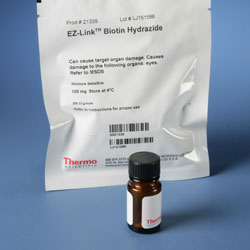
Thermo Scientific EZ-Link Hydrazide-Biotin is the shortest and simplest hydrazide-activated biotinylation reagent for labeling glycoproteins and other carbohydrate-containing compounds having oxidizable sugars or aldehydes.
Thermo Scientific EZ-Link Hydrazide-LC-Biotin is a mid-length, simple, hydrazide-activated biotinylation reagent for labeling glycoproteins and other carbohydrate-containing compounds having oxidizable sugars or aldehydes.
These biotin hydrazide reagents enable simple and efficient biotin labeling of polyclonal antibodies and other glycoproteins. Mild oxidation of antibodies with sodium periodate produces reactive aldehydes on the carbohydrate moieties of the Fc portion that can be modified by hydrazides. This approach is advantageous for labeling antibodies because biotinylation occurs only at the sites of glycosylation, which are primarily in the Fc region of the antibody, far from the antigen binding site.
Highlights:
-
Glycoprotein labeling – biotinylate glycosylated proteins at sialic acid residues for detection or purification using streptavidin probes or resins
-
Cell surface labeling – biotinylate and isolate cell surface glycoproteins
-
Aldehyde-reactive – reacts with aldehydes formed by periodate-oxidation of sugar groups
-
Hydrazide-activated – perform reactions at pH 4 to 6 in buffers such as sodium acetate
-
Irreversible – forms semi-permanent hydrazone bonds; spacer arm cannot be cleaved
-
Solubility – usually dissolved in DMSO before further dilution in aqueous buffers
-
Two lengths – spacer arms (lengths added to targets) are 15.7 and 24.7 angstroms, respectively
Product Details:

|

|
|
Chemical structures of Hydrazide-Biotin compounds. These biotinylation reagents label glycoproteins and other molecules having carbohydrates that can be oxidized with periodate to expose aldehydes. For more information, see our review of Hydrazide Reaction Chemistry.
|
Properties of EZ-Link Hydrazide-Biotin Labeling Reagents. The aldehyde-reactive biotinylation reagents have simply, alkyl-chain spacer arms.
|
|
Hydrazide-Biotin
(Part No. 21339)
|
Hydrazide-LC-Biotin
(Part No. 21340)
|
|
Alternative names
|
Biotin-hydrazide
Hydrazide-activated biotin
|
Biotin-LC-hydrazide
Long-chain hydrazide-activated biotin
|
|
Chemical name
|
(biotinyl)hydrazide
|
6-(biotinamido)hexanehydrazide
|
|
SMILES structure
|
O=C(CCCCC(SC1)C2C1NC(N2)=O)NN
|
O=C(CCCCCNC(CCCCC (SC1)C2C1NC(N2)=O)=O)NN
|
|
Molecular formula
|
C10H18N4SO2
|
C16H29N5SO3
|
|
Molecular weight
|
258.34
|
371.50
|
|
Spacer arm length
|
15.7 angstroms
|
24.7 angstroms
|
|
Mass added to target
|
240.11daltons
|
353.27 daltons
|
|
CAS number
|
66640-86-6
|
109276-34-8
|
|
Form
|
White powder
|
White to off-white powder
|
|
Solubility
|
Approx. 5mM in water; approx. 50mM in DMSO; poorly soluble in DMF
|
|
Storage conditions
|
4°C
|
|
Reactive groups
|
Hydrazide, reacts with aldehydes at pH 4 to 6
|
We manufacture biotin reagents to ensure the highest possible overall product integrity, consistency and performance for the intended research applications.
Biotinylation reagents differ in reactivity, length, solubility, cell permeability and cleavability. Hydrazides and alkoxyamines are two types of carbonyl-reactive groups. Hydrazides (–NH-NH2) react specifically with aldehyde groups in slightly acidic conditions to form hydrazone linkages; these can be further reduced to stable secondary amine bonds using sodium cyanoborohydride (Part No. 44892). The reaction is more efficient in the presence of aniline (Part No. 88944). Alternatively, hydrazides can be conjugated to carboxylic acids using EDC carbodiimide chemistry.
Reactive aldehyde groups can be generated in glycoproteins and other polysaccharide compounds by oxidation of constituent sugar diols using sodium periodiate (Part No. 20504). Sialic acid residues are common components of protein glycosylation and are easily converted to aldehydes with 1mM NaIO4.
References:
-
O'Shannessey, D.J., et al. (1984) A novel procedure for labeling immunoglobulins by conjugation to oligosaccharide moieties. Immunol. Lett. 8, 273-277.
-
Kähne, T. and Ansorge, S. (1994) Non-radioactive labeling and immunoprecipitation analysis of leukocyte surface proteins using different methods of protein biotinylation. J. Immunol. Methods 168, 209-218.
-
Bayer, E.A., et al. (1988) Biocytin hydrazide-a selective label for sialic acids, galactose, and other sugars in glycoconjugates using avidin-biotin technology. Anal. Biochem. 170, 271-281.O’Shannessey, D.J. and Quarles, R.H. (1987) Labeling of the oligosaccharide moieties of immunoglobulins. J. Immunol. Meth. 99, 153-161.
-
O'Shannessy, D. J. and Quarles R.H. (1985) Specific conjugation reactions of the oligosaccharide moieties of immunoglobulins. J. Appl. Biochem. 7, 347-355.
-
O'Shannessey, D.J., et al. (1987) Quantitation of glycoproteins on electroblots using the biotin-streptavidin complex. Anal. Biochem. 163, 204-209.
-
Reisfield, A., et al. (1987) Nonradioactive hybridization probes prepared by the reaction of biotin hydrazide with DNA. Biochem. Biophys. Res. Com. 142, 519-526.
-
Rosenberg , M.B., et al. (1986) Receptor binding activities of biotinylated derivatives of ß-nerve growth factor. J. Neurochem. 46, 641-648.
-
Scott, M.G., et al. (2000) Cationic Antimicrobial Peptides Block the Binding of Lipopolysaccharide (LPS) to LPS Binding Protein. J. Immunol. 164, 549-553.
-
Wade, D.P., et al. (1985) Detection of the low density-lipoprotein receptor with biotin-low density lipoprotein. Biochem. J. 229, 785-790.
Related Resources:
Biotinylation Reagents Selection Guide
Review of Biotinylation Methods and Applications
Review of Glycosylation and Glycoprotein Methods
Chemistry of Crosslinking (and Labeling Reagents)
Related Products:
Hydrazide-PEG4-Biotin – long, hydrophilic, PEGylated spacer arm
Sodium meta-Periodate – carbohydrate oxidation reagent
All Biotinylation Reagents
Avidin, Streptavidin, NeutrAvidin Affinity Resins
|
 首页>
生物试剂>
发光、交联及生物分子相互作用系统>
分子交联
首页>
生物试剂>
发光、交联及生物分子相互作用系统>
分子交联
 会员登录
会员登录.getTime()%>)
 购物车()
购物车()

 成功收藏产品
成功收藏产品


